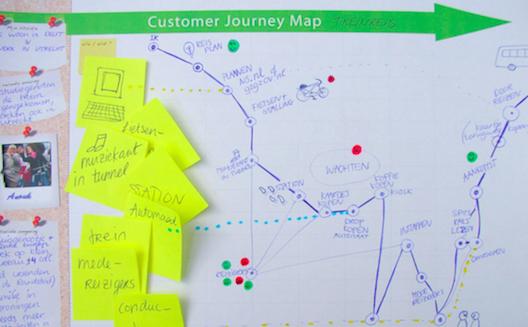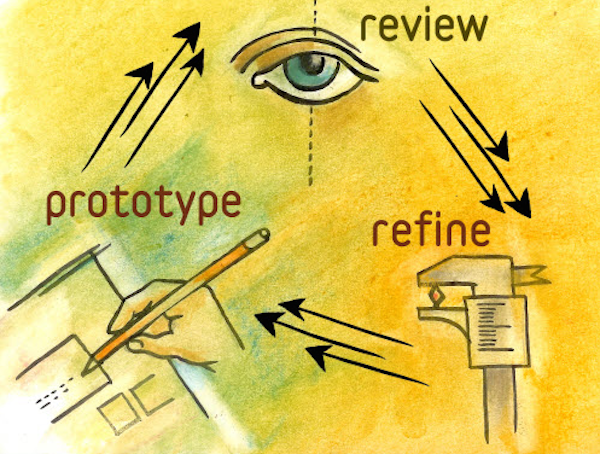Prototyping and the art in hardware creation: White Lab


Prototyping is a product development process made up of tests
and iterations. (Image via smashingmagazine.com)
“Between the conception and the creation, falls the shadow…”
Those words are paraphrased from T.S. Elliot’s poem, The Hollow Men.
In the poem, Elliot was portraying the languorous moral state of humanity, but he also captured the fundamental Maker’s dilemma and a challenge faced by aspiring hardware entrepreneurs: effective solutions to a real problem are not easy to conceive; and the process to manifest those ideas into a sustainable business is often unclear and arduous.
Prototyping is one method of design-innovation that hardware entrepreneurs can use to act on their ideas and emerge step by step from the shadow between conception and creation.

To learn more about how entrepreneurs use prototyping for crafting ideas into the physical world, Wamda sat down with the creators behind White Lab.
Eve Tamraz, left, cofounder and CTO of White Lab. (Image via White Lab)
White Lab, is a Lebanese startup and healthcare analytics company that specializes in environmental detection. The company was cofounded by Cyrille Najjar (CEO), a Royal College of Art graduate in industrial-product design, and Eve Tamraz (CTO) who has a PhD in neurosciences and studied at the Ecole Normale Supérieure de Paris.
The cofounders spoke with Wamda about the theory of prototyping, common misconceptions, best practices, and their latest creation, Air.

Cyrille Najjar, right, founder and CEO of White Lab. (Image via lorientlejour.com)
Wamda: Why do you prototype?
Eve Tamraz: Prototyping is how you really learn. You try, and try, and iterate, and refine something until you see results that indicate that what you are doing is working. This is what makes a product perfect in the end.
Cyrille Najjar: We do it to validate that something is possible, that it can be done before we commit tons of resources to it.
Wamda: Why is prototyping especially useful in hardware design?
Najjar: Hardware is held, so you have to design experiments that allow feeling. Traditionally, our brains are our chief mechanism for discovery, and it makes us prone to want to completely understand something before diving into it. Prototyping is a bit counterintuitive in that regard; in that you are trusting that your hands are as smart as your brain, and that making something by feeling is equally viable for leading you in the right direction as thinking about it in the abstract.

The lips
and hands are huge because they are the most sensitive parts of our
bodies; critical considerations in hardware design. (Image via
drscottmills.com)
Wamda: How do you go about conceiving an idea for a prototype?
Najjar: You have to think about why you are prototyping in the first place. You have to answer the question, “what is the real need of the target market I am trying to serve?”
Keep in mind, as you design different versions of your prototype, you are iterating the design to reflect a greater understanding of your target-market’s wants, needs, and pain-points.

Building a customer journey map means observing the user’s
experience and then representing that experience on paper through
the various touch-points. (Image via
servicedesigntools.org)
Wamda: What are some practical steps for building the first prototype?
Najjar: Start with generating some user-journeys and possible usage-scenarios based on what people say they need (and what they are not getting).
The goal here is to get a sense of what the product does even before understanding how it will work. Once you’ve done that, you can build a rudimentary prototype and test it with your audience.
Based on your results, you can begin to map out the products functions and technical components, then the structural design, and finally the visual appearance.
Wamda: What are some common prototyping mistakes?
Tamraz: Don’t put too much money into your first designs. You can develop a proof-of-concept with basic items that don’t cost much if you are rigorous in your data collection strategies. Also, don’t expect it to be perfect right away; you may go through ten prototypes before settling on one that satisfies your goal.
Wamda: Can you tell me about an experience when prototyping triggered a powerful insight for you?
Najjar: It happened when we
developed the world’s first single piece violin with a technology
that allows the instrument to be carved using a method that came
from Formula 1 and spaceship design. We uncovered the insight about
how valuable learning through feel can be; and about how
intelligent hands are in the design thinking process for developing
hardware.
The Air Violin is developed from technology used in Formula 1
and spaceship design. (Image via White Lab)
Tamraz: We were able to make multiple prototypes of the violin for our client by 3D printing designs before actually carving the body of the instrument out of wood. Each subsequent design yielded new insights into our client’s user-experience; that we then factored into new prototypes and ultimately into the final product.
Wamda: Can you tell us about Air?
Tamraz: Air, is the first smart allergen tracker. We are utilizing Internet of Things technology, predictive analytics, and hardware design to address the issues of respiratory allergies, the tremendous costs this places on healthcare systems each year, and the fact that preventative solutions have been hard to implement; until now.

Air is White Lab’s first product and the first smart allergen
tracker. (Image via White Lab)
Wamda: What exactly are you offering with Air?
Najjar: Air, offers 24/7 indoor air quality analysis and detects and alerts you based on the presence of allergens and irritants as well as smoke and gas leaks.
Using our application and a proprietary algorithm we also offer custom data analytics using mobile allergy logs and corresponding air quality measurements for personalized and predictive medicine.
On top of all that, we can also give you tailored advice that helps you alter your environment to reduce exposure to allergens and irritants and ultimately create a healthier place to live.
Prototyping
is both a scientific process and much more
From obtaining a deep insight into your user’s experience, to the subsequent low-budget prototypes, tests, iterations, and onto more sophisticated designs, you are essentially building physical experiments to validate your hypotheses. Much like the standard scientific method.
However, throughout that process you are also uncovering a unique narrative that defines the way your users feel the elements of the product, and then you find a way to incorporate those feelings into the most salient touch-points of the final design; and that, is the essence of prototyping and the art in hardware creation.


